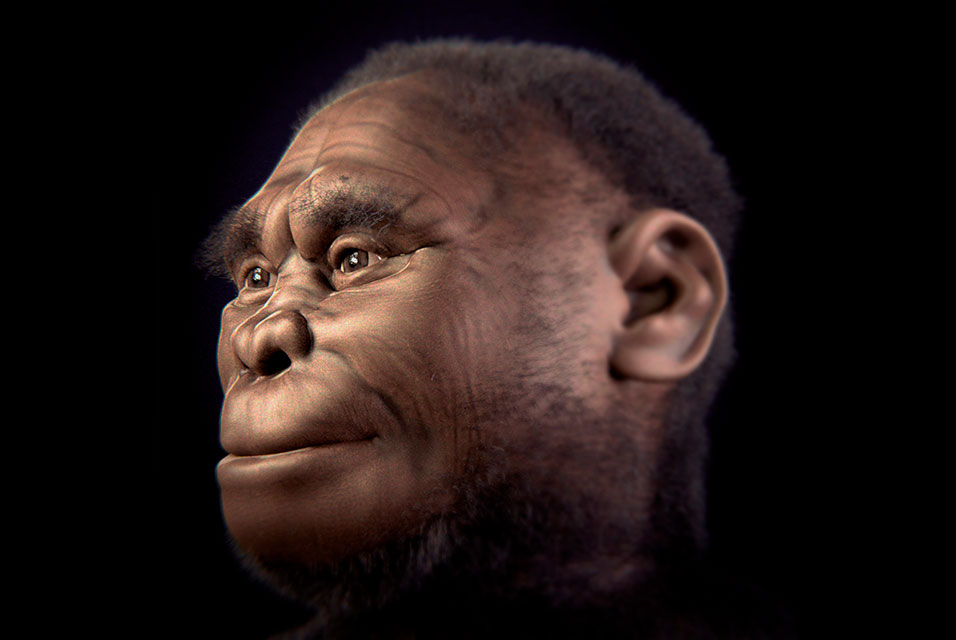LONDON.- At just over one metre tall, the ancient human species Homo floresiensis might have been slight in stature, but it has attracted lengthy debate due to its mysterious origins.
H. floresiensis has been said to be a relative of Homo erectus, an offshoot of a far more ancient human ancestor or even a diseased population of modern humans. But it can't be all three, so which is most likely?
Discovered in a cave in Indonesia in 2003, Homo floresiensis seems to have lived not long before modern humans appeared in the region.
At the start of this millennium, most palaeoanthropologists believed that only modern humans - our species, Homo sapiens - had managed to travel beyond the Southeast Asian mainland towards New Guinea and Australia. It seemed very unlikely that archaic humans had watercraft capable of crossing the ocean. The discovery of Homo floresiensis on a remote Indonesian island changed things dramatically.
Homo floresiensis facts
• Lived: at least 100,000 to about 50,000 years ago
• Where: the island of Flores, Indonesia
• Appearance: short with a very small skull, definite brow ridge, short legs and large, flat feet
• Brain size: about 420cm3
• Height: about 1.05-1.10m
• Weight: about 25kg
• Diet: largely unknown, but probably included meat
• Species named in: 2004
• Name meaning: 'human from Flores' - sometimes referred to as Flores Man
Where did Homo floresiensis live?
The ancient human species Homo floresiensis lived on the remote island of Flores in Indonesia, about 500 kilometres to the east of Java. All of the fossils unearthed to date were found in a huge cave called Liang Bua, which means 'cool cave'.
Some much older finds have been made at the site of Mata Menge, about 70 kilometres further east on the island. Experts think these human relatives, called hominins, may be related to the Homo floresiensis population found at Liang Bua.
Important Homo floresiensis fossils
Homo floresiensis was discovered in 2003 on an expedition led by the archaeologist Mike Morwood. In continuing excavations, the team uncovered more than 100 Homo floresiensis fossils at Liang Bua, including the partial skeleton of a female, labelled Liang Bua 1 or LB1, and fragmentary fossils of at least 13 more individuals.
When did Homo floresiensis live?
Exactly when Homo floresiensis appeared on Flores is unclear, but the oldest known remains are at least 100,000 years old, while some stone tools attributed to Homo floresiensis are as much as 190,000 years old.
As mentioned, scientists found older fossils on the island - a 700,000-year-old jawbone and teeth - that may be from a related hominin population.
When Homo floresiensis was first discovered, the team dated the fossil skeleton to less than 20,000 years old. If the species was present on Flores that recently, it would mean that a primitive hominin had survived on the island well into the era of modern humans.
However, the age of the skeleton was later revised to about 60,000 years old, with an estimated last appearance of Homo floresiensis about 50,000 years ago, based on stone tools.
So far, no modern human remains have been found in the region as early as 50,000 years ago, so this revised date might mean Homo floresiensis was physically extinct before the appearance of modern humans in the region.
What did Homo floresiensis look like?
Homo floresiensis was very short compared to the average modern human, standing at about 1.05 metres tall. This is what earned Homo floresiensis its nickname 'the hobbit', after a fictional group of human-like creatures created by JRR Tolkien.
When Homo floresiensis was first discovered, archaeologists thought it must be the skeleton of a modern human child. However, the tiny skull had defined brow ridges, which are not characteristic of modern humans, and the individual had fully developed wisdom teeth, indicating it was an adult not a child.
Along with a very small brain - around 420 centimetres cubed in volume, about a third of the size of our brains - Homo floresiensis had an unusual body shape. The hipbones were broad and flared, the collarbone was short and the shoulder joint was positioned quite far forwards. The species also had large, flat feet.
Individuals from Liang Bua also show foot, hand, wrist and jaw traits that look more primitive than those of any human dating to within the past million years.
These archaic characteristics bear similarities to some species of australopithecines. Australopiths represent a more ancient branch of hominins - the family tree to which modern humans, extinct human species and all our immediate ancestors belong. This might suggest Homo floresiensis evolved from a very ancient divergence in the hominin family tree.
Yet Homo floresiensis also shares characteristics in common with our more recent relative, Homo erectus, for example, aspects of the skull shape.
This puzzling combination of characteristics has fuelled an ongoing debate around Homo floresiensis' place in the story of human evolution.
How was Homo floresiensis different in appearance from Homo sapiens?
Along with its smaller stature and large, flat feet, Homo floresiensis had other physical traits that were different to those of modern humans. These included a tiny skull with a small braincase, protruding brow ridges and no prominent chin. In comparison, Homo sapiens have a high and rounded braincase, a small face tucked under the forehead, small and separated brow ridges and a chin on the lower jaw.
Homo floresiensis' wide hips and shoulders also differ from our species' relatively narrow body.
Why was Homo floresiensis so small?
There are several theories as to why Homo floresiensis was so small.
The team who discovered Homo floresiensis originally proposed that a population of the species Homo erectus travelled to Flores from Java, perhaps by boat, and once on Flores they shrunk in size over hundreds of thousands of years. This is an example of insular dwarfism, also called island dwarfism, a process where large animals isolated on islands evolve smaller bodies because they have limited resources and no large predators to defend themselves against.
However, the australopithecine-like physical characteristics of Homo floresiensis suggest it evolved from a far more ancient and smaller ancestor than Homo erectus.
Some other scientists suggested that Homo floresiensis is not a distinct species but rather a population of Homo sapiens with a condition such as microcephaly, where the brain develops to a smaller size. However, there are no known diseases or conditions in Homo sapiens that match what we find in Homo floresiensis and finds on the island from about 700,000 years ago already show some of its traits.
So is Homo floresiensis a separate human species?
Yes - while we don't have all the answers as to how it developed its unique set of traits, Homo floresiensis is a distinct human species.
The lively, ongoing debate is why the discovery of Homo floresiensis is an important chapter in the ever-unfolding story of the human journey. It demonstrates how an unexpected find like Homo floresiensis can contribute to our understanding of human evolution and cause us to question our previous assumptions.
Interestingly, another small-bodied human species, Homo luzonensis, was recently found nearly 3,000 miles away in the Philippines. This species has been dated to at least 50,000-67,000 years old, making it around the same age as Homo floresiensis. However, while they share some characteristics in common, Homo floresiensis and Homo luzonensis bear varying combinations of characteristics, which identify them as two separate human species.
Discoveries such as Homo floresiensis and Homo luzonensis provide a particularly valuable contribution to our understanding of ancient human diversity in Asia and Southeast Asia, which is currently poorly represented in the fossil record.
Evidence of the ancient ancestor of Homo floresiensis
Scientists aren't yet sure how long ago Homo floresiensis evolved, but there is evidence that its ancestor lived on Flores for hundreds of thousands of years.
Stone tools found at the Wolo Sege site on Flores indicate that an early human species was present on Flores about one million years ago. In addition, fragments of human fossils dated to about 700,000 years ago were discovered at Mata Menge in central Flores. These fossils include teeth that are the same size or even smaller than those found at Liang Bua, supporting the idea that Homo floresiensis, or its ancestor, was on Flores at least 700,000 years ago.
What did Homo floresiensis eat?
We don't know much about the diet of Homo floresiensis. Current evidence suggests it involved both plants and uncooked meat, with tooth wear indicating a tough, fibrous diet that required lots of forceful chewing.
Charcoal, stone tools and the bones of the elephant-like Stegodon were found in the Liang Bua Cave. Initially it was thought that these might be evidence that Homo floresiensis could use fire and hunted and butchered Stegodons for food, but they have now been attributed to a later occupation of the cave by Homo sapiens. However, it is still possible that Homo floresiensis ate raw meat from Stegodons, Komodo dragons and rodents, the remains of which have all been found in the cave.
When did Homo floresiensis go extinct?
The last known trace of Homo floresiensis dates to about 50,000 years ago, with the earliest evidence of Homo sapiens on Flores appearing shortly after, about 46,000 years ago.
This means that Homo floresiensis is one of several early human species that went extinct during the period when modern humans were starting to flourish around the world. Neanderthals, Denisovans, Homo luzonensis and possibly Homo erectus also seem to have become physically extinct as modern humans were spreading and growing in number.
So why did Homo floresiensis go extinct? We can't say for sure. However, it is a possibility that the extinction of Homo floresiensis and the emergence of Homo sapiens are connected in some way.
Could Homo floresiensis still be alive today?
Some people have suggested that Flores Man is still alive and there have been claimed sightings of little, hairy humans or human-like individuals in the forests. Sceptics think it's unlikely that a population big enough to sustain itself could have remained largely unobserved given the island's small size and density of occupation.
While there is a community of people of shorter-than-average height living on Flores today, they are not genetically related to Homo floresiensis.
Are there more exciting fossil discoveries to come?
If the ancestors of Homo floresiensis reached Flores and those of Homo luzonensis reached the Philippines, perhaps ancient humans also spread to other isolated islands in the region.
This might not have involved intentional travel, but instead accidental rafting on mats of vegetation following a volcanic eruption or earthquake, such as happened in the 2004 Indian Ocean tsunami, often called the Boxing Day tsunami. Some people survived on floating debris for a week or more, travelling about 150 kilometres, 93 miles, out to sea.
There may be many illuminating fossils in the region still waiting to be discovered.










